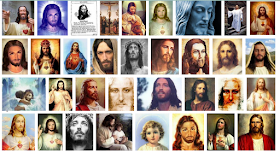If asked, most people will acknowledge that Jesus was not the blue-eyed, wavy-haired man of Sunday School fame. Nevertheless, this imagery persists as the most common depiction of Jesus produced by media, and indeed, by churches.
White Jesus readily comes to mind in conversations, and presumably even in moments of prayer or worship. When shown several pictures of Jesus in a variety of ethnicities, Christians "accepted the visual material intellectually, but not emotionally."(p. 251) Indeed "to imagine Jesus as other-than-white would demand a conscious process of unlearning." (p.15)
 |
| Jesus is white, because Google knows everything. |
Images are powerful, and take hold more readily than politically-correct rhetoric and diversity seminars. The authors observe that "civil rights, [and] cultural pluralism...led these whites to change verbally but not materially. The result was that the white Jesus and white privilege were denounced by everyone, but they remained as still-powerful material realities." (p. 250)
| He sure look white to me... |
If Jesus is white is so many minds, how does the behavior of white folks taint the representation of Him? I'm not sure white folk should want Him associated with their actions. Indeed, from early on in American history, the contradiction has caused many to reject a God touted by such a cruel race.
Some have been able to accept Jesus, while not adopting his whiteness. There have been many movements to either de-color, or to re-color the Christ. Liberation theologists, among others, have produced Asian Jesus, Chicano Jesus, Yogi Jesus, Black Jesus, and scholars have used forensic archaeology to discern Jesus's 'true appearance.'
| Jesus: white and dreamy |
Today, the tradition continues. The authors observe that '"new movies and television shows rendered Jesus as white without proclaiming it or defending it. They allowed Americans to adore and cheer a savior in white skin as they professed to believe in a God that did not discriminate." (p. 255)
What are the consequences of the predominant perceptions of a white Jesus? Theologians have noted that "if we accept a White Jesus, if that is the image we see, we have also adopted an image of salvation, of health, wholeness, happiness, that also comes to us via a White culture and comes to us with a White value system." (p. 228) This imagery reinforces the 'white savior complex' and perpetuates the tenancy of white folk to view themselves as morally superior to other groups.
| Diverse children....white Jesus |
One is left with a question of what to do with all of their well-researched information. Where do we go from here? And how does this history change our actions today? I suppose these sorts of questions are left to we as the readers to fully examine in our own lives.
No comments:
Post a Comment